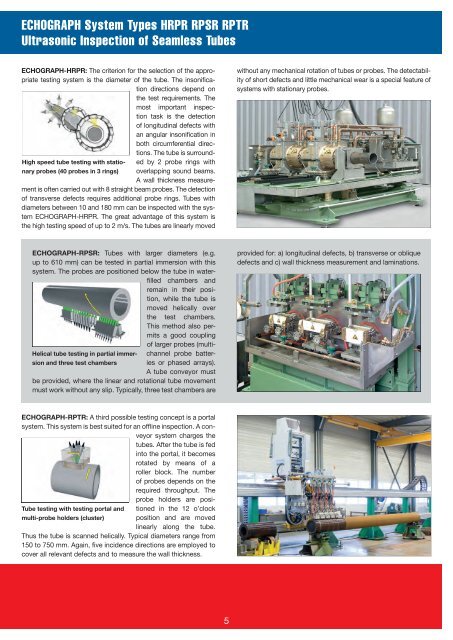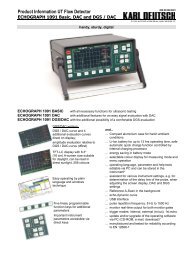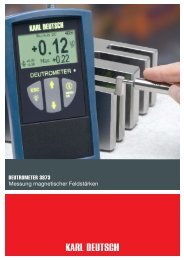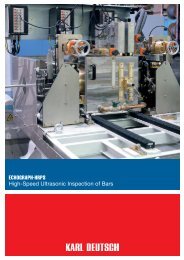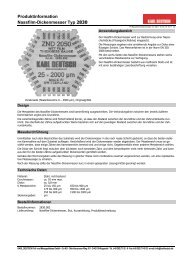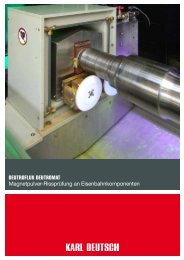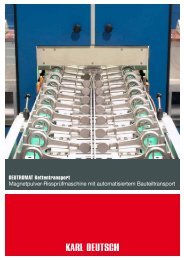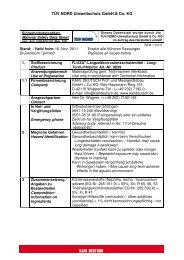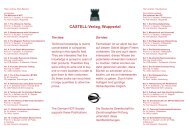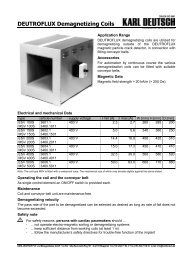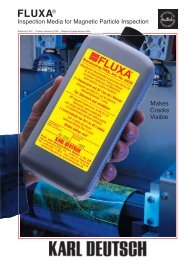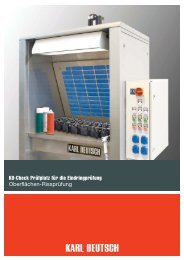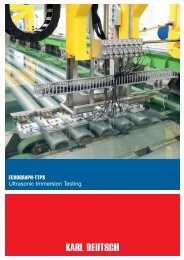here - Karl Deutsch
here - Karl Deutsch
here - Karl Deutsch
- TAGS
- karl
- www.karldeutsch.de
You also want an ePaper? Increase the reach of your titles
YUMPU automatically turns print PDFs into web optimized ePapers that Google loves.
ECHOGRAPH System Types HRPR RPSR RPTR<br />
Ultrasonic Inspection of Seamless Tubes<br />
ECHOGRAPH-HRPR: The criterion for the selection of the appropriate<br />
testing system is the diameter of the tube. The insonification<br />
directions depend on<br />
the test requirements. The<br />
most important inspec-<br />
High speed tube testing with statiotion<br />
task is the detection<br />
of longitudinal defects with<br />
an angular insonification in<br />
both circumferential directions.<br />
The tube is surrounded<br />
by 2 probe rings with<br />
nary probes (40 probes in 3 rings) overlapping sound beams.<br />
A wall thickness measurement<br />
is often carried out with 8 straight beam probes. The detection<br />
of transverse defects requires additional probe rings. Tubes with<br />
diameters between 10 and 180 mm can be inspected with the system<br />
ECHOGRAPH-HRPR. The great advantage of this system is<br />
the high testing speed of up to 2 m/s. The tubes are linearly moved<br />
ECHOGRAPH-RPSR: Tubes with larger diameters (e.g.<br />
up to 610 mm) can be tested in partial immersion with this<br />
system. The probes are positioned below the tube in waterfilled<br />
chambers and<br />
remain in their position,<br />
while the tube is<br />
moved helically over<br />
the test chambers.<br />
Helical tube testing in partial immer-<br />
This method also permits<br />
a good coupling<br />
of larger probes (multichannel<br />
probe battersion<br />
and three test chambers ies or phased arrays).<br />
A tube conveyor must<br />
be provided, w<strong>here</strong> the linear and rotational tube movement<br />
must work without any slip. Typically, three test chambers are<br />
ECHOGRAPH-RPTR: A third possible testing concept is a portal<br />
system. This system is best suited for an offline inspection. A conveyor<br />
system charges the<br />
tubes. After the tube is fed<br />
into the portal, it becomes<br />
rotated by means of a<br />
roller block. The number<br />
of probes depends on the<br />
required throughput. The<br />
probe holders are posi-<br />
Tube testing with testing portal and tioned in the 12 o’clock<br />
multi-probe holders (cluster)<br />
position and are moved<br />
linearly along the tube.<br />
Thus the tube is scanned helically. Typical diameters range from<br />
150 to 750 mm. Again, five incidence directions are employed to<br />
cover all relevant defects and to measure the wall thickness.<br />
5<br />
without any mechanical rotation of tubes or probes. The detectability<br />
of short defects and little mechanical wear is a special feature of<br />
systems with stationary probes.<br />
provided for: a) longitudinal defects, b) transverse or oblique<br />
defects and c) wall thickness measurement and laminations.


